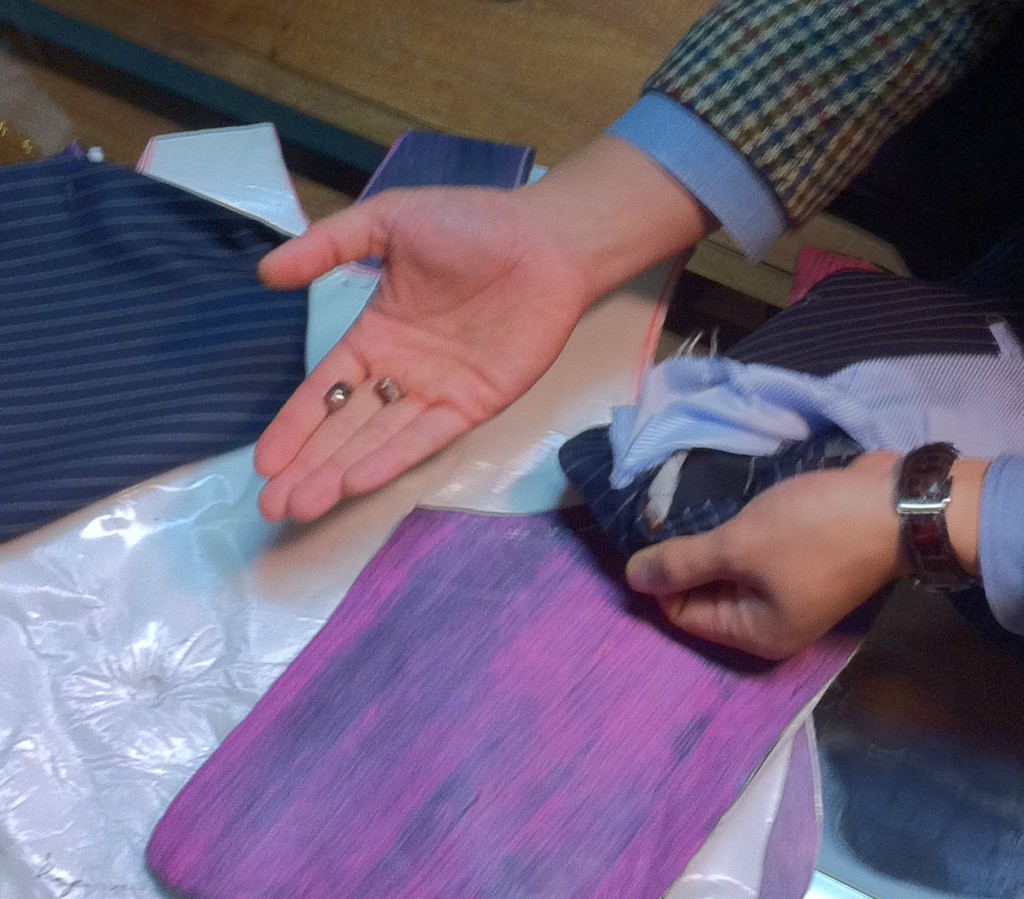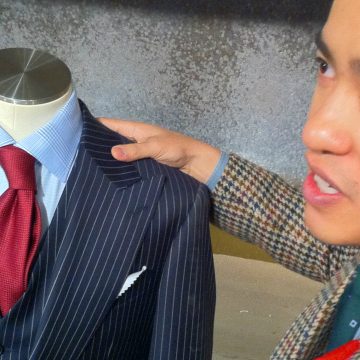At the far end of the shooting range, sitting atop a wooden platform, sits the headless torso of a male mannequin. It’s dressed in a high-end navy-blue pinstripe suit and a man is pointing a .40-calibre handgun at the lifeless figure. The man fires three bullets. Each shot pierces the right breast of the jacket and disappears, as if the suit absorbs them entirely.
This scene played out earlier this week when Garrison Bespoke, a Toronto-based menswear retailer, tested its bulletproof suit for the media at the Ajax Rod and Gun Club. It’s like something from a James Bond movie: stylish, badass, and depending on the province, you may need a licence to wear it.
 Upon closer inspection, the suit did, in a sense, absorb the gunfire: the bullets penetrated the suit jacket, but didn’t pass through the vest. After cutting the vest open, Michael Nguyen, co-owner of Garrison Bespoke, revealed several bullets caught by the inner lining, which provides protection from bullets shot from a typical handgun.
Upon closer inspection, the suit did, in a sense, absorb the gunfire: the bullets penetrated the suit jacket, but didn’t pass through the vest. After cutting the vest open, Michael Nguyen, co-owner of Garrison Bespoke, revealed several bullets caught by the inner lining, which provides protection from bullets shot from a typical handgun.
The deceptively thin lining contains multiple layers of materials developed by an American company for the U.S. Special Forces — the company worked with Garrison Bespoke on the condition of anonymity.
The lining itself has two sections. The first contains several sheets of fabric made with carbon nanotubes, which are cylinders of carbon about one nanometre in diameter — a strand of hair, in contrast, is around 90,000 nanometres wide. Because nanotubes are 100 times stronger than steel and 50 percent lighter than Kevlar (the industry standard for bulletproof vests since the 1970s) they can be added to fabrics or metals to increase their strength and make them lighter. The second section of the lining is a series of plastic-like panels that act as shock absorbers, preventing serious bruising and internal damage.
In addition to being bulletproof, the suits are also stab-proof. Nguyen says his team tested this feature at his shop: tailors donned the suit and allowed staff to go at them with a knife.
The price for the suit starts at $20,000 and Nguyen expects to sell one per month.
Nguyen is getting into a market that traditionally caters to wealthy executives and politicians who travel to dangerous countries on business.
During his inauguration, for instance, Barack Obama is rumoured to have worn a bullet-resistant suit provided by Colombian designer Miguel Caballero, the most prominent provider of style-minded body armour. Caballero has garnered attention in the past for garbing journalists in his products and shooting them himself.
Nguyen, however, describes Caballero’s suits as “very bulky and full-fitting.” Nguyen says the bulletproof technology in his own suits is more discreet, which in turn makes them safer: if someone is going to a dangerous meeting, he explains, conspicuous bulletproof clothing could be interpreted as a sign of bad faith and increase the risk of violence.
Another key difference between the two designers is that Caballero, in an effort to keep his products out of criminal hands, performs background checks on every customer. Nguyen does not, explaining: “There are people who turn their lives around and we don’t want to judge who should or should not have this protection.”
Under Ontario law, Nguyen is not obligated to take precautions before selling his products, but other provinces do regulate the sale of body armour — generally defined as clothing that can withstand gunfire or knife attacks.
In British Columbia and Manitoba, for example, it’s illegal to buy or sell body armour without a licence. In Alberta, only buyers need a permit, but retailers are expected to verify their customers have a permit or are from an exempted group, which includes police officers, ambulance attendants, firefighters and licenced gun owners. Violations can result in a $10,000 fine, a six-month prison stint or both.
These provinces, generally, argue that body armour should not be available to everyone because it intimidates the public and can be used by criminals in drive-by shootings or firefights with police.
Calgary-based criminal lawyer Michael Bates is not convinced that Alberta’s law, which came into effect last summer, will do anything to curb criminal activity.
“If gang members decide to do a drive-by shooting,” he says, “they aren’t going to say, ‘I was going to go and try to murder a whole bunch of my opponents, but because I can’t have a bulletproof vest legally, I’m going to change my mind now.’ It’s absurd.”
Bates says that, on a fundamental level, all body armour, including a bulletproof suit, is benign because on their own they cannot inflict harm.
Police in Toronto hold a similar position. “Body armour is not going to do anything without a gun,” says Victor Kwong, spokesperson for the Toronto Police Service. “We are putting all of our energy into enforcing the law that says guns and ammunition are restricted or prohibited.”
Bates also says that judges and lawyers sometimes receive threats and should not, in those instances, be forced to apply for a permit to purchase bulletproof clothing. “They shouldn’t have to get the government’s permission to take a step to do something which is protective of themselves or their family.”
Still, even in Ontario’s regulation-free market, $20,000 bulletproof suits are outside the price range of most people. Nguyen hopes to lower the price over time by reducing the time it takes to produce each suit (it currently takes 120 hours). For now though, he has his eye on some high-profile customers.
“One of our clients had dinner with the Clintons on the weekend and he was talking about [our suit] over dinner,” he says. “We don’t make any womenswear but [if Hilary ends up getting to the White House], we might make an exception for her inauguration.”


